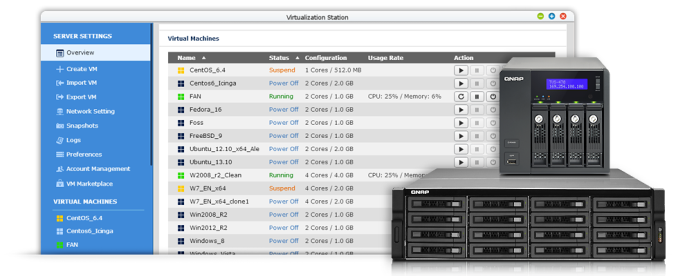QNAP TS-x51 NAS Series: Intel Quick Sync Gets its Killer App
by Ganesh T S on June 22, 2014 6:45 PM ESTVirtualization for Home Users
QNAP heavily played up their unique Virtualization Station package when I talked to them at CES earlier this year. At that time, they were focusing on the TVS-x70. Quite frankly, I thought it would be a niche feature targeting very high-end SMB and enterprise customers. Users in that segment have traditionally preferred to separate their virtualization and network storage platforms, and are resistant to change. At that time, my impression was that It might take a couple of generations for Virtualization Station to catch on in that market segment.
Now that QNAP is playing up Virtualization Station as a trump card for the TS-x51 series (albeit with the restriction that only 1 VM can be run, and the NAS has to have more than 2GB of RAM), I began to think about this more. In their marketing spiel, QNAP portrays using the VM feature for fulfilling functionality available only on certain OSes. The example provided was that of a printer with drivers available only for Windows.
Power users running Windows on their HTPCs often use the unit for other tasks too. In fact, the popularity of the 'multiple concurrent users on a single PC' article on Missing Remote stands testimony to this fact. Others might have a physical PC at home used in a 'headless' manner, i.e, no display attached and just accessed through the 'Remote Desktop' feature. Typical use cases include home automation servers or just running download tasks (say, JDownloader or torrents or anything similar). In the case that users want to run those tasks on a NAS (and avoid the PC altogether), they have usually been forced to rely on 'apps' from the NAS vendor or 'third-party apps' for fulfilling the required functionality.
The availability of a NAS to act as a VM host enables users to run their OS of choice, say Windows. Most required functionality can be implemented / is already available on Windows. The apps can then be run on the VM (and in addition, they have direct local access to the storage too, without going through the network). These type of use-cases make Virtualization Station a very nifty feature.
QNAP's implementation does leave scope for improvements, though. For example, running a VM takes out one of the network ports for NAS usage in the TS-x51 series. While allowing the host OS to share the network port with the guest OS might preclude link aggregation, it could be useful in other scenarios where the NAS is shared between two different networks. Obviously, we also need to see how much performance gets affected while running VMs. All said, QNAP has to be given credit for being the first NAS vendor (to our knowledge) to release a OS with VM host capabilities.











49 Comments
View All Comments
rikm - Sunday, June 22, 2014 - link
the slide says "All new tubro" , kind of like turbo, but not quite that fast?wintermute000 - Sunday, June 22, 2014 - link
look forward to benches + real world transcoding testing.In particular want to see if everything is covered or there are any notable exceptions in terms of codec/container
SilthDraeth - Sunday, June 22, 2014 - link
Tubro, faster than snailro, just barely.ganeshts - Monday, June 23, 2014 - link
Didn't see that typo in their marketing brochure, to be honest :)Just spent some time fixing up the image at my end, so it should be OK now.
[-Stash-] - Monday, June 23, 2014 - link
Quick, hit the Turbo Button!steveoat - Sunday, June 22, 2014 - link
Looks interesting. What will be the costs of the 4 and 6 bay units?DanNeely - Sunday, June 22, 2014 - link
Probably similar to that of their current x69 series which are $540/712 for the bay and $782/925 for the 6 bay models on Amazon depending on if you go with the L or Pro models.Skarn - Sunday, June 22, 2014 - link
I'll be looking forward to seeing a full review of these units once samples become available. I'd especially like to know if the GPU driver baked in to drive the HDMI port fix the tearing problems I've seen on Sandy Bridge GPUs. While the feature set is sufficient that I'd be interested in these units despite this issue, I find tearing quite bothersome. I'd also be interested in seeing a full list of supported video codecs.ganeshts - Monday, June 23, 2014 - link
I wouldn't hold my hopes too high.. Intel GPUs' Linux drivers for video playback have historically been 'unreliable'. (That is why I wasn't too enthused about XBMC and HDMI output on the Evansport-based NAS units from Thecus and Asustor).That said, the list of supported codecs for transcoding input would definitely be something to evaluate and look into in greater details.
haardrr - Monday, June 23, 2014 - link
the latest intel drivers for linux 14.04 are amazing... (at least for the mythtv)...i know mythtv is NOT the same as a NAS box...
BUT, if the OS on this NAS is 14.04 (or similiar) you should not have any of the problems you have described.